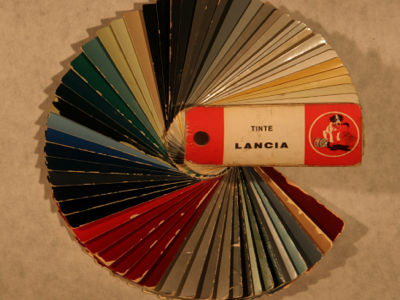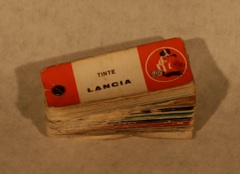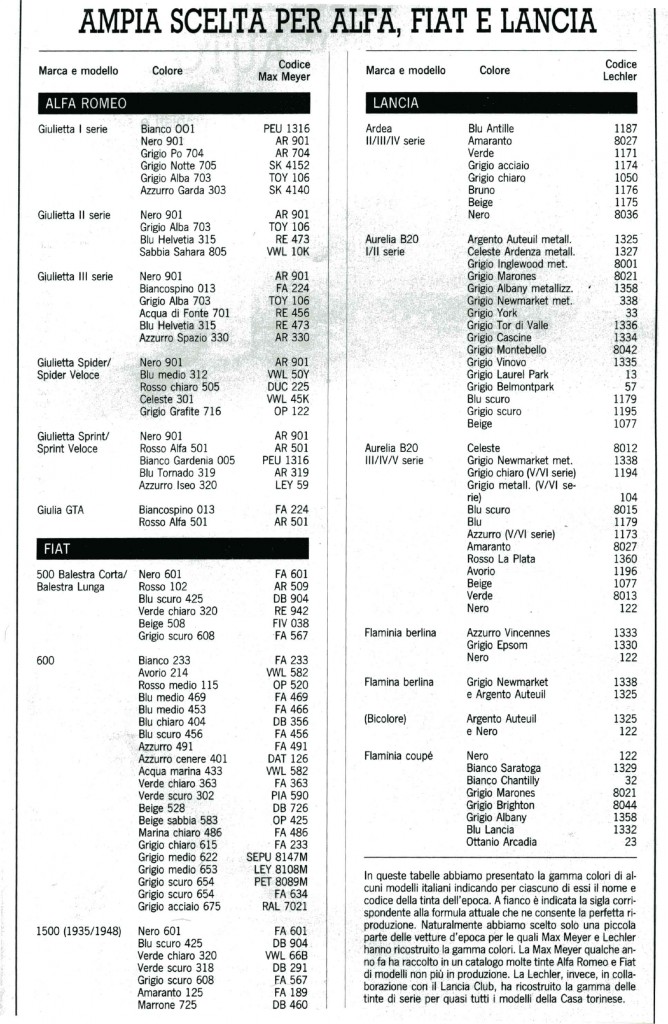Archive for the ‘Aurelia’ Category
Roadtrip
In late July, I was able to find a spare week and to focus on the restoration. It was off to Europe in search of parts.
First, arrrival into Zurich from Chicago – using mileage, the trip was cheap and very direct. Rent-a-car with GPS made navigation to Como area very simple.
Staying overnight by the lake allowed for the early morning run along this magnificent lake, followed by some visits to local Aurelia shops, where cars in restoration were seen and information exchanged.
The next day was spent gathering parts and working with Cavalitto in Turin. Enrico there is a very thoughtful man, and he has a very careful way of working. First, he starts with the s. 1 parts book, then cross references parts back to the B12 parts book to get the later Lancia part numbers (they changed c. 1954-55). Then he goes to his computer to check inventory and location. Get the part, put it in the bag, label the bag, staple it. Next item? And of course in Italy, interruptions seem to happen all the time…. So my offers of coffee, biscuits, humor, assistance were gently turned aside while they focused on the work. After a while I was able to assist this process and put the labels on the bags. Anything to help!
I was able to meet with Guido Rosani who was generous enough to show his projects, and he was kind enough to share xeroxes of some early de Virgilio sketches. Questions about Aurelia cams have been more clealry resolved and further enhanced – after looking at de Virgilio’s early original hand sketches, his use of geometry and calculation is very clear. More on that later. Needless to say, access to this information is pretty exciting.
Parts were found for a friend here as well, and his Appia differential was packed with my parts into the two boxes, now weighing about 60 lbs, and put into the car, for the trip up to Switzerland.
There I was able to spend time with a B50 up close, and visit an Aprilia cabriolet, Motom motorcycle, and even a Lambda.
As an architect, it was quite interesting to see the new Swiss architecture, and Basel was quite fascinating. On the Swiss national holiday in early August, it was quite easy to go from site to site and see the buildings without traffic or difficulty. And of course, there was the visit to the lovely s. 2 B20 just outside Basel, with the color scheme of light tan and light brown cloth. Carefully documented, it will now serve as a baseline for our restoration here.
There was the brief conversation with a mechanic in Basel who started working at Lancia in 1951, and did his schooling and training there. Now 73, he still works on particular cars, one at a time, at a small Lancia concessionaire in the area.
Upon returning home, the head was spinning with having seen so much in a few days, and having met some wonderful folks and seeing these cars in their context. The hills of Switzerland and Italy are great places for these cars, and those people who can tumble out of their house and go for a mountain drive are lucky to say the least.
Thanks to this Lancia community for such hospitality and graciousness.








Bodywork in May and June
Current work has focused on repair of sheet metal. While the car has a good sound body, there has been some metal replacement, nothing unusual. The shop working on the car (Skip at McCabe Restorations) is pretty familiar with 1950’s Italian cars, and the sheet metal work is fairly straightforward.
The photos show (clockwise from top left):
1) work on the front end, and replacement of one of the headlight buckets and a bit of work on the front end (correct some geometry at the grille).
2,3) the tail fins have been repaired to go back to original smaller tail lights. Luckily there was a great deal of undisturbed metal, and by not modifying what was original metal, plus contouring per the original bumper, we were able to reconstruct the fin profile pretty clearly.
4) rocker repair – the outer skin has been removed, and the two inner skins are visible. Skip says this work is extremely straightforward from here on out.
5) Fuji and Skip doing a quick contour check. They found a straight line on the car along the top of the rockers (at the bottom of the door openings), and ran a string to check for the shape of the rear quarters on both sides – which were overall within 1/8” of each other, pretty good!
Interestingly, I was lucky to have received a number of photos of s. 2 cars, and the shapes of the fins do vary from car to car. Some are more pronounced, others a bit softer in shape. But like the rest of the car, its classic lines keep changing depending on where you are looking from.
Current paint codes
Here is the full list of Lechler paint codes for Lancias, as published in 1990 in Ruotoclassiche. The list is provided with thanks to Carter Hendricks.
Lechler numbers:
Oh, to buy one now!
How much did Lancias cost? One part of that question is how much did it cost then vs. now. However, back then, it also depended on where you bought the car. The prices varied a great deal by country. For example, a B10 bought in Italy in 1951 cost $2,928, but was 35% more if bought in Switzerland.
The first place to start is Rosani’s article in “Storia della Lancia”, where prices are listed for all the models in Italy, from that time and 1991 equivalents. Jean-Pierre Baumgartner has also provided prices from Lancia if purchased in Switzerland in 1952. These are summarized in the first table below. To facilitate comparisons, the Italian and Swiss prices are then converted to US$ in the second table.
A few interesting facts emerge. For example,
– a B21 was 15% more expensive than a B10 in Italy.
– a B20 was about 50% more than a B10 in Italy.
– a s.2 B20 cost about $4,600 in Italy, but $ 7,209 in Switzerland (1952).
– a B24 Spider cost $5,325 (1955) in the US and $6,900 in Switzerland.
– B20 prices in the US varied. The s.4 was $6,175 in 1955 by Inskip and in 1958, it was listed at $5,830 by Hoffman, which was about $1,200 more than in Italy.
1. here are the Italian prices along with Swiss prices:
1950’s Lira 1991 Lira 1952 Swiss Fr.
B10 1951 1,830,000 36,253,000 18,150
B21 1951 2,305,000 41,621,000 22,600
B20 (1) 1951 2,870,000 51,823,000
B20 (2) 1952 31,000
B20 (5) 1956 2,922,000 43,565,000
B24 (4) 1955 2,822,000 29,500
Alfa 2500 SS 1952 43,700
Ferrari 212 Inter 48,000
2. Next, the same information (1950s prices) but in US$ equivalents (early prices from a Lancia letter from 1952. Later prices by importer ads, as noted):
Italy US Switzerland
B10 1951 $2,928 $3,305 $4,220
B21 1951 $3,688 $3,727 $5,255
B20 (1) 1951 $4,592
B20 (2) 1952 $4,645 $7,209
B20 (4) 1955 $4,675 $6,175*
B20 (5) 1956 $5,830**
B24 (4) 1955 $5,325*** $6,900
Alfa 2500 SS 1952 $10,162
Ferrari 212 Inter $11,162
* from a 1955 Inskip price list
** from a 1958 ad by Hoffman
*** from a 1955 Inskip advert
The US prices were pretty close to the prices in Italy. A Swiss customer paid quite a bit more. A B20 in Italy might cost $ 4,645, but if bought across the border in Switzerland, would cost $7,209. By comparison, an Alfa 2500 SS cost over $10,000 and a Ferrari 212 was over $11,000.
A B24 Spider would cost $6,900 in Switzerland, however that same Spider was advertised in 1955 by Inskip in the US for $ 5,325.
By 1958 prices had changed in the US – the coupe and the B24 convertible were being officially imported by Hoffman, and were listed for $5,830.
One other thing that is (to me) very interesting. The list price of a B20 didn’t change very much in Italy during the 1950’s. The first series was listed at 2,870,000 lira, the fourth series at 2,822,000 (per Lancia PR material in my collection), and the fifth at 2,922,000.
But if one looks at the prices in 1991 equivalents, a very different story emerges: Rosani notes that the first series is (in 1991) priced at 51,823,000 lira, and the fifth series is 43,565,000 lira. This corresponds to about an 18% drop in price due simply to depreciation of the Italian lira. Did this matter? It is hard to know for sure. Perhaps the cost of labor and goods in Italy in the 1950’s did not reflect this so quickly. Nevertheless, this is a pretty large devaluation, and may have had some impact on Lancia’s fiscal health.
Interior details
What were the interiors of a B20? They appear not to be standardized, especially not the early ones. Later ones (from 4th series on) are more regular, with the later 6th series being the most predictable, according to the literature.
Did the interiors of the earlier cars have door panels in cloth or vinyl? Most think they were cloth, maybe some vinyl along the bottom.Thus, an early car would be cloth around the driver, not only on the seats, the door panels but also the headliner. Two s.2 cars were examined, one having the seat “buttons” which were sometimes installed. Note the it also has vinyl on the seat sides, where the other one has cloth. Vinyl on the seat backs was common.
Here are some pictures of redone door panels with vinyl on the top and bottom and cloth in the middle. This is fairly practical.

- redone 2nd s. panel, vinyl on bottom
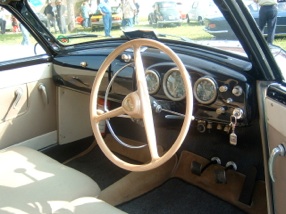

redone 4th s. with vinyl trim and bottom
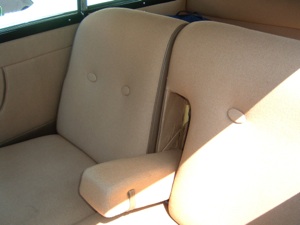

very well done 2nd series, with vinyl on bottom
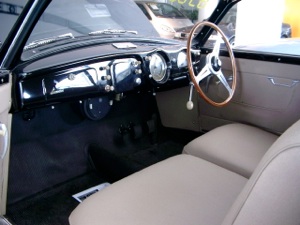
The real trick was to find unrestored cars, however. And they tell a different story: an original 1st series interior shows use of the vinyl detailing was original:

original s.1 B20 panel – note the vinyl
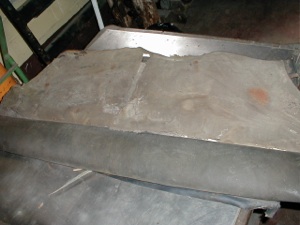
Then there are some panels from a 2nd series interior, also unrestored, which show all vinyl (I believe) on the rear quarter panels and heavy use of vinyl on the door panel:
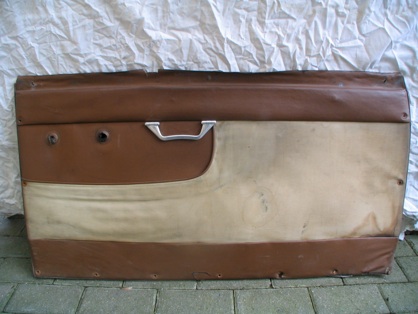
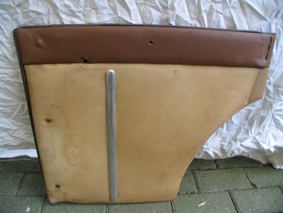
- unrestored rear quarter panel from original s.2 B20
Lastly, a s,4 B20 was found with an original all leather interior. While uncommon, it did look nice.
This car used to belong to Bill Shakespeare, in southern Illinois, of Bugatti fame. The car was originally a two tone green car (when I saw it in 1980) but is now been repainted to a single green. Some “speciale” cars had their interiors in full leather, nice to see how they looked.
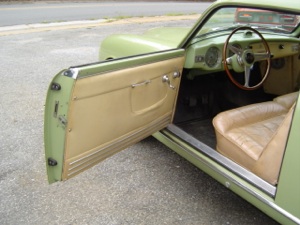
full leather interior, unrestored s.4 B20
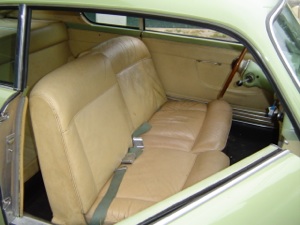
So what are the colors?
The color research is beginning to pay off. From Carter Hendricks comes a xerox of a 1990 article in an Italian magazine, which says: “ from work by Elvira Ruocco & others… who worked to transfer old Fiat, Lancia and Alfa paint color codes to current Lechler and other color codes.” So here are the 1990 Lechler codes for the Aurelias B20’s from that article (my transcribing, but their exact words!). There are some later corrections from Lechler in Italy from recent correspondence, indicated by ( ). One can assume the later numbers are more likely to be correct, but take care!
B20 1, 2 series:
- Argento Aureuil metall. 1325
- Celeste Ardenza metall. 1327
- Grigio Inglewood met. 8001
- Grigio Marones 8021
- Grigio Albany metallizz. 1358
- Grigio Newmarket met. 1338
- Grigio York 33
- Grigio Tor di Valle 1336
- Grigio Cascine 1334
- Grigio Montebello 8042
- Grigio Vinovo 1335
- Grigio Laurel Park 13 (1181)
- Grigio Belmontpark 57 (8083)
- Blu Scuro 1195 (Lechler uses same number called Grigio Scuro)
- Beige 1077
For the B20 s. 3,4,5 (6 isn’t listed separately):
- Celeste 8012
- Grigio Newmarket met. 1338
- Grigio Chiaro, V/VI series 1194
- Grigio Metal.,V/VI series 104 (Lechler calls this Grigio Milano Metal.)
- Blu Scuro 8015
- Blu 1179
- Azzuro, V/VI serie 1173
- Amaranto 8027 (1176)
- Rosso La Plata 1360
- Avorio 1196
- Beige 1077
- Verde 8013
- Nero 122
A few more thoughts:
A Max Meyer colorwheel from the 1950’s lists some of these paints, but with older (no longer valid) numbers. In that wheel, the “Lancia Blue” is listed as MM # 1.272.7069, and is probably the same as the Blu above.
And the Lancia beige is probably the same as Max Meyers’ “Beige Mirabello” (old # 1.252.3918). Jean-Pierre Baumgartner sent me the following sample which he said had some 30+ years of age on it:
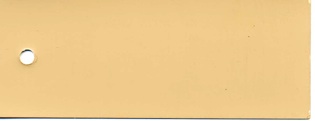
For the B24, we have a color wheel (image from Steve Katzman) with the following paints:
- B24 Spider color wheel
The colors are the older MM paint codes and names for which we do not have the Lechler equivalents, but here they are regardless:
- Grigio Metall, – 16.249
- Rosso Capri- 10.593
- Verde Alassio – 13.665
- Celeste Portofino- 10.573
- Grigio Forte del Marmi- 10.702
- Avorio Riccione- 12.002
For other information on colors, such as Flavia colors and Fulvia colors (Lechler #’s and Lancia #’s) can be found in either Viva Lancia’s online library, or in: the Lancisti Community, look in their library and search for colors. Paul Mayo has also done quite a bit of work on colors.
For Ardea and Appia colors – a detailed list of Max Meyer paints can be found in the book by Puttini & Fornai, published by Nada.
A Max Meyer color wheel in England is shown below, but again numbers from MM are not translated to current paint codes. So its an interesting period piece, but of little direct help.
